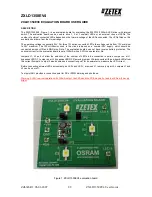
http://www.tyan.com
157
Glossary
ACPI (Advanced Configuration and Power Interface):
a power management
specification that allows the operating system to control the amount of power
distributed to the computer’s devices. Devices not in use can be turned off, reducing
unnecessary power expenditure.
AGP (Accelerated Graphics Port):
a PCI-based interface which was designed
specifically for demands of 3D graphics applications. The 32-bit AGP channel
directly links the graphics controller to the main memory. While the channel runs
only at 66 MHz, it supports data transmission during both the rising and falling ends
of the clock cycle, yielding an effective speed of 133 MHz.
ATAPI (AT Attachment Packet Interface):
also known as IDE or ATA; a drive
implementation that includes the disk controller on the device itself. It allows CD-
ROMs and tape drives to be configured as master or slave devices, just like HDDs.
ATX:
the form factor designed to replace the AT form factor. It improves on the AT
design by rotating the board 90 degrees, so that the IDE connectors are closer to
the drive bays, and the CPU is closer to the power supply and cooling fan. The
keyboard, mouse, USB, serial, and parallel ports are built-in.
Bandwidth:
refers to carrying capacity. The greater the bandwidth, the more data
the bus, phone line, or other electrical path can carry. Greater bandwidth results in
greater speed.
BBS (BIOS Boot Specification):
a feature within the BIOS that creates, prioritizes,
and maintains a list of all Initial Program Load (IPL) devices, and then stores that
list in NVRAM. IPL devices have the ability to load and execute an OS, as well as
provide the ability to return to the BIOS if the OS load process fails. At that point,
the next IPL device is called upon to attempt loading of the OS.
BIOS (Basic Input/Output System):
the program that resides in the ROM chip,
which provides the basic instructions for controlling your computer’s hardware. Both
the operating system and application software use BIOS routines to ensure
compatibility.
Buffer:
a portion of RAM which is used to temporarily store data; usually from an
application though it is also used when printing and in most keyboard drivers. The
CPU can manipulate data in a buffer before copying it to a disk drive. While this
improves system performance (reading to or writing from a disk drive a single time
is much faster than doing so repeatedly) there is the possibility of losing your data
should the system crash. Information in a buffer is temporarily stored, not
permanently saved.
Содержание S7105
Страница 2: ...http www tyan com 2 ...
Страница 11: ...http www tyan com 11 2 2 Block Diagram S7105 Block Diagram ...
Страница 12: ...http www tyan com 12 2 3 Mainboard Mechanical Drawing ...
Страница 15: ...http www tyan com 15 Jumper Legend OPEN Jumper OFF Without jumper cover CLOSED Jumper ON With jumper cover ...
Страница 22: ...http www tyan com 22 2 5 LED Definitions ...
Страница 45: ...http www tyan com 45 3 3 1 1 Add an Attempt Read only NOTE Only LAN1 supports iSCSI function ...
Страница 56: ...http www tyan com 56 3 3 2 1 1 1 1 Volume0 RAID0 Stripe 708 0GB Normal Read only ...
Страница 78: ...http www tyan com 78 3 3 14 AST2500 Super IO Configuration Super IO Chip Read only ...
Страница 81: ...http www tyan com 81 ...
Страница 85: ...http www tyan com 85 PCH DFX Configuration PCH DFX Configuration Options ...
Страница 98: ...http www tyan com 98 3 4 3 Server ME Configuration Read only ...
Страница 103: ...http www tyan com 103 Numa Enable or Disable Non uniform Memory Access NUMA Disabled Enabled ...
Страница 106: ...http www tyan com 106 3 5 3 1 UPI Status Read only ...
Страница 108: ...http www tyan com 108 3 5 4 1 Memory Topology Read only ...
Страница 120: ...http www tyan com 120 3 5 5 4 Intel VMD Technology ...
Страница 132: ...http www tyan com 132 Server Management Port 2 IPV6 Support Enable or Disable LAN1 IPV6 Support Enabled Disabled ...
Страница 154: ...http www tyan com 154 BIOS Temp Sensor Name Explanation ...







































